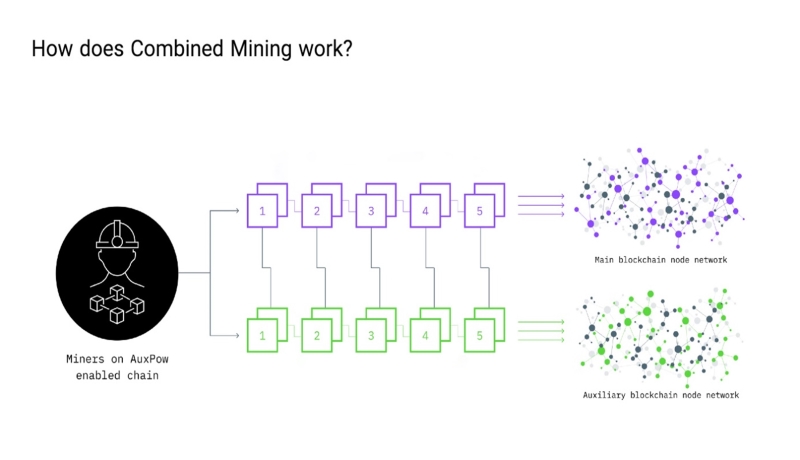What is Combined Mining or Dual Mining?
Combined Mining is a protocol that allows the user to perform the extraction process in two different blockchains with the same consensus protocol and hash function without losing performance and maintaining a high level of security. In this way, the Miner can be rewarded from several networks and, as a result, will earn more profit.
If you want to learn more about compound extraction and its details and how it works and enjoy the benefits of this process, do not miss reading this article.
What is Combined Extraction?
Around 2014, a new mining model was introduced in which the Miner could extract blocks in two or more different blockchains; The concept is now known as hybrid extraction or dual extraction.
Although the blockchains of each digital currency are completely independent of each other, miners can use their extraction power (hash rate) to create a valid hash for the two networks. Although the concept of Combined Mining may lead to the belief that the Miner needs more computing power to extract blocks in two or more different blockchains, in reality, this mining model does not affect the performance of the mining equipment.

In this mining model, the Miner can use his computing power to generate different hashes and examine them in several blockchains. If one of the hashes is valid for Bitcoin, for example, the Miner will receive a reward in the form of BTC; Or if the hash is valid for the Namecoin network, Miner will receive its reward in the form of NMC ciphers.
History of the concept of hybrid extraction
The concept of Combined Mining originated in early 2014, when Auxiliary Proof of Work, or AuxPoW for short, was introduced. Additional work proof is a protocol that allows the user to use work done on a PoW blockchain network as proof of work on another blockchain network to extract a block.
The AuxPoW protocol was initially implemented in bitcoin and semi-bitcoin blocks. This was made possible because both blockchains operate under the same mining algorithm, SHA-256. One of the main requirements of this protocol is that selected blockchains should have a similar extraction algorithm. Development of AuxPoW then continued using this protocol on Dodge Coin and Light Coin networks. Both cryptocurrencies use the same algorithm to extract their block.
Although the concept of dual Mining is not explicitly mentioned in the white paper bitcoin, the legendary creator of bitcoin, Satoshi Nakamoto, by publishing several posts in the bitcointalk community, has made it possible for miners to share computing power to search for proof of work on multiple networks simultaneously. . This shows that Nakamoto had already foreseen the possibility of this kind of work and opened the door to curiosity to build and develop it.
How does dual extraction work?
Combined Mining is certainly not an easy task. Extensive research was done to develop the AuxPoW protocol to enable hash mining and validation in two or more different blockchain networks. All of this had to be done so that the performance of none of these networks was compromised. With this in mind, the developers succeeded in creating this mining protocol, thus making the most of their equipment extraction power in several blockchains simultaneously.
When dual extraction is performed, one blockchain network acts as the primary network (source or parent blockchain) and another as an auxiliary network (auxiliary blockchain). In other words, there will always be a blockchain network in which the Miner does the whole process of calculating and extracting the block (e.g., bitcoin). In contrast, the other network uses these processes as proof of work to extract the block in The network accepts (for example, Mim coin).

For networks involved in hybrid extraction to accept this process, the main network must allow the desired data to enter the extracted block headers. The auxiliary network must have an authentication process to indicate that mining work has been done on the main network. For this purpose, in the auxiliary network, the AuxPoW protocol adds specific information critical to the proper functioning of this protocol and network. This information helps the helper network validate the block and store it properly in its blockchain.
In the Combined Mining process, miners must build a block compatible with the blocks involved. For example, if dual extraction is used for bitcoin and semi-bitcoin blocks, the block created in the bitcoin blockchain is suitable for both networks. In this case, Mim coin is an auxiliary network and, therefore, accepts AuxPoW. In this case, the Miner can receive extraction rewards from both networks. Whereas if a block is generated in a semi-coin network with a much lower difficulty level than the original blockchain, that block will not be compatible with the bitcoin blockchain; Because Bitcoin does not recognize the AuxPoW protocol. Therefore, Miner will only receive the extraction bonus in the NimQueen network.
Advantages of combined extraction
With dual or combined Mining, it is possible to use the same mining equipment to generate new blocks in two or more different blockchains simultaneously. This increases the profitability and performance of mining equipment.
Similarly, dual extraction increases the hash power of blockchain networks, creating more computing power for the networks and increasing their difficulty level. Having more computing capacity or hashing makes networks more secure and robust. This can be a big advantage for small blockchains that do not have much hash power and, as a result, do not have very high security. Thus, through Combined Mining, these networks can harness the hash power of a larger, more powerful blockchain and reduce the likelihood of attacks by increasing their security. A great example is a half coin with a small blockchain, but its security level is very similar to bitcoin thanks to its difficulty of extraction.
Miners implementing hybrid extraction have much more potential to generate new blocks using a similar extraction algorithm, such as SHA-256. Therefore, it is much more likely to receive network rewards for block extraction.
Disadvantages of combined extraction
Mining pools that want to implement the AuxPoW protocol for hybrid Mining in multiple blockchains must manage at least two or more of these networks to be able to mine them.
The alternative blockchain must be modified for Combined Mining to be effective, generally a hard fork. For example, in the case of bitcoin, important adjustments were made to the network to make it compatible with dual extraction. Therefore, this network’s old and new versions are no longer compatible with block number 19,200.
In addition, for mixed extraction to work properly, miners must use blockchains that have the same extraction algorithm.
Some applications of Combined Mining
Bitcoin and Half Coin (Namecoin)
The first dual extraction in the crypto industry occurred in bitcoin and semi-coin networks in early 2014. Both cryptocurrencies use the SHA-256 extraction algorithm.
Although half a coin was one of the most valuable cryptocurrencies at the time, today, despite its integration with the Bitcoin network, it ranks 644th in the digital currency rankings in terms of market value. Bitcoin, meanwhile, remains the world’s largest and most widely used digital currency.











